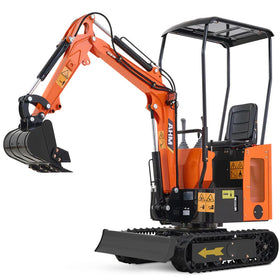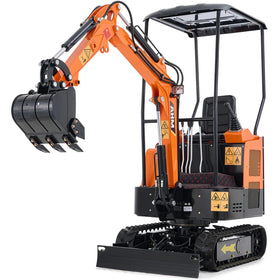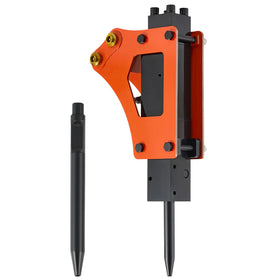Maybe you've got water pooling against your foundation after every rainstorm, or you're just tired of mowing grass that looks like a roller coaster. Can you actually grade a yard with a mini excavator?
Well, here's the thing - you can grade a yard with a mini-excavator, especially a small to moderately sized yard. Grading with a mini excavator can be incredibly effective when you know what you're doing, and it's often the perfect solution for residential projects where bigger machines simply won't fit.
Whether you're dealing with drainage issues, preparing for new landscaping, or just want a level yard that doesn't make your ankles hurt, learning how to grade a yard properly will save you thousands in professional fees and give you results you can be proud of.

When Does Mini Excavator Grading Make Sense?
Let's get straight to the point - grading with a mini excavator isn't always the best choice, but when it is, it's absolutely brilliant. Here's when you should seriously consider this instead of calling in the big guns.
It is Perfect for Yards with Many Obstacles
Got a yard full of stumps, rocks, or landscaping you want to keep? This is where mini excavators absolutely shine.
- While larger grading equipment would bulldoze right through your prize rose bushes, a mini excavator lets you work around obstacles with surgical precision.
- You can remove that stubborn stump and grade around your favorite tree in the same afternoon.
It is Best for Areas with Tight Access
With a mini-excavator, you can grade a yard with a mini excavator if it is trapped behind a house with limited access, or has gates, fences, or narrow paths that might be hard to navigate.
These machines can squeeze through 36-inch gates and work in spaces where traditional graders simply fear to go.
A Mini Excavator Works When You’re on a Budget
Let's be honest - renting a full-size grader for a weekend costs significantly more than a mini excavator. Fortimes when you have to seriously consider “how much to grade a yard?”, mini excavators often offer the best bang for buck.

How to Grade Your Yard with a Mini Excavator
Alright, now that you know when it makes sense, let's dig into the actual process of grading with a mini excavator. This isn't rocket science, but there are definitely right and wrong ways to do it.
What You'll Need Before Starting
You'll need the right attachments to grade your yard with a mini-excavator. A standard digging bucket won't cut it for grading work.
- You'll want a grading bucket that matches your machine's track width for optimal stability and control.
- Many operators also swear by tilt buckets for creating precise drainage slopes.
Don't forget about your mini excavator's blade - it's not just for stabilization. That blade becomes your precision grading tool, and understanding how to use it properly makes the difference between amateur and professional results.
Step 1: Assess and Plan Your Grade
Before you fire up that machine, you need a clear picture of what you're trying to achieve.
- If you are grading a yard for drainage, you need a minimum 2% slope away from structures - that's about 1/4 inch drop per foot.
- For most residential applications, a 2-3% grade provides excellent drainage without creating erosion problems.
Walk your property and identify high and low spots. Use spray paint or stakes to mark areas that need attention. Remember, water always wins - work with natural drainage patterns, not against them.
Step 2: Loosen and Prepare the Soil
In most cases, your mini excavator will not be powerful enough to just push through concrete-hard ground.
Point your bucket teeth straight down and rake the ground in several passes until the soil is workable, when the soil moisture is moderate.
Step 3: Rough Grading with Your Bucket
Start with rough grading to mark your basic contours. Here's the key technique most people miss: only move over about one-third of your bucket width for each new pass.
- If you try to use the full bucket width, soil rolls around the edges, creating uneven ridges instead of smooth grades.
- Work in manageable 20x20-foot sections, which will help maintain consistent grading across larger areas.
Step 4: Blade Work for Precision
Position your blade slightly above ground level before beginning operations. This starting position allows you to gauge material movement and establish optimal cutting depth.
The key is maintaining consistent material accumulation in front of the blade - watch how the soil rolls, it should form an even ribbon across the blade's width.

Pro Tips for Mini Excavator Grading Success
Now here's where we separate the weekend warriors from the pros. These tips for grading with a mini excavator will make your results look professional instead of like your drunk uncle tried to level his yard after a few beers.
Use Your Mini Excavator for Initial Work, then Finish with Skid Steer
This is the secret sauce that most DIYers never learn. Grading with a mini excavator is fantastic for rough work, removing obstacles, and establishing major contours. But for that final smooth finish?
Switch to a skid steer loader with a grading blade, giving you the best of both worlds. In fact, you’ll see many professional contractors use this exact technique on residential projects.
Work Different Soil Types Strategically
Pick your battles carefully - sandy soil shifts easily, so work in smaller 15x15-foot sections and let the bucket's weight do the work rather than forcing it. On the other hand, you should start with a toothed bucket to loosen rocky soil and remove larger rocks before switching to your grading bucket.
Working with clay soil needs patience - work it when the moisture content is just right and make multiple light passes rather than trying to move large amounts at once.
Best Mini Excavators for Your Grading Projects
Once you've mastered the technique, you'll need quality equipment that won't let you down. That's where AHM's mini excavator lineup really shines - these machines are specifically engineered for the precise control that yard grading projects demand.
1. AX-12B Series ($5,999.99)
With 13.5 HP and 69-inch dig depth, the AX-12B delivers impressive capabilities at an unbeatable price. The compact 2,138 lb operating weight means less ground pressure on your freshly graded surfaces, while the intuitive controls make learning proper grading techniques much easier.
2. AX-16 Series ($8,599.99-$9,399.99)
When you need more power for challenging grading projects, the AX-16 mini excavator series delivers 23 HP with enhanced 3,262 lbf digging force.
3. AY-25 Series ($25,999.99-$26,599.99)
When you're ready for serious grading work, the AY-25 series brings 25 HP Perkins diesel engines with 108.3-inch dig depth and 992 lb lifting capacity. The available enclosed cab (AY-25J) makes all-weather grading projects comfortable and efficient.
The Bottom Line on Yard Grading
So, how do you grade a yard with a mini excavator? Now you know that it's absolutely doable with the right approach, proper equipment, and realistic expectations about what these versatile machines can do.
With AHM's reliable mini excavator lineup and the techniques we've covered, you can transform your soggy, uneven yard into a properly graded landscape that manages water effectively and looks professionally done, at a fraction of the cost.
FAQ: Grading Your Yard with a Mini Excavator
Q: When is a mini excavator the best choice for grading my yard?
A: Mini excavators are ideal if your yard has lots of obstacles like tree stumps or rocks, or if you have tight spaces that big machines just can’t get into. They’re also great if you want to save some money but still get great results!
Q: What attachments do I need for grading with a mini excavator?
A: You’ll want a grading bucket designed for smooth soil movement, not just a digging bucket. Also, don’t forget about using the mini excavator’s blade—it’s super helpful for precise grading.
Q: How steep should I make the slope for proper drainage?
A: Aim for about a 2% slope away from your house or structures—that’s roughly a quarter inch drop per foot. This helps water flow away without causing erosion.
Q: What should I do before starting the grading work?
A: Walk your yard to spot high and low areas, mark them with paint or stakes, and plan your slope direction. If the soil is hard, use the bucket teeth to loosen it up before moving dirt around.
Q: Any tips for operating the mini excavator to get the best finish?
A: When you’re rough grading, only move about one-third of your bucket width at a time—this avoids uneven ridges. Then use the blade for smoother, final passes to get a nice, even finish.
Q: How do I handle different soil types?
A: For sandy soils, work in smaller sections and let the bucket’s weight do the work. Rocky soil needs loosening with a toothed bucket first. For clay, choose a time when the soil is moist but not too wet and make gentle, light passes.
Q: Should I use other machines to finish the job?
A: Many pros use a skid steer or similar machine for the final touch after the mini excavator has done the heavy lifting. This combo gives you the best of both worlds: rough grading power and smooth finishing.







